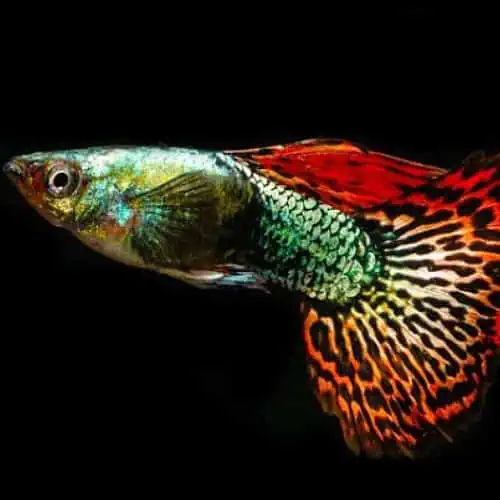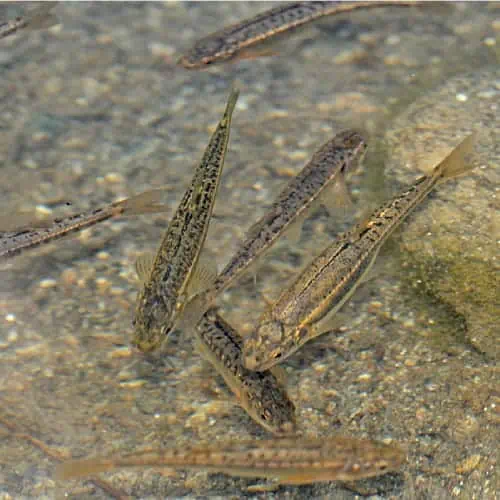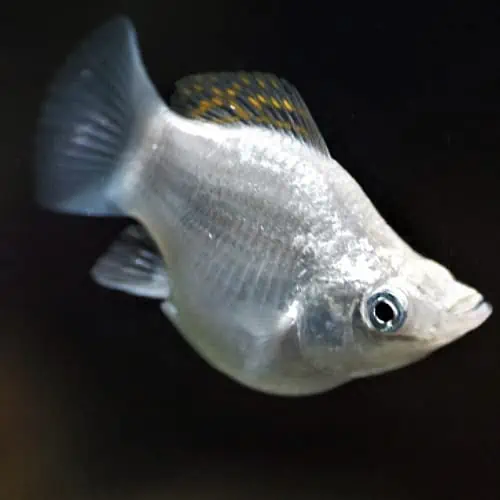
Koi are the domesticated descendants of the common carp, which are naturally rather calm and easily tamed. As a result of this as well as centuries of domestication, koi are customarily gentle giants that get along well with each other and many other creatures as well, so long as their dietary needs and water quality requirements are met.
However, they are opportunistic omnivores, and are known to eat smaller fish species as well as fry if they have the opportunity. In fact, they’ll even eat their own fry! Females lay thousands of eggs, and leading up to the time that these hatch they will often nibble on them. In some cases, such as when pond is overstocked or there is too little food, koi siblings may eat each other for sustenance as well as to reduce competition. However, these instances aren’t common and so long as you keep your koi healthy and with appropriate pond mates, all of your pond’s residents should live strong, happy lives!
Make sure to feed your koi a balanced diet and keep your pond within the necessary parameters – water temperature should be between 59 and 77 degrees Fahrenheit (15 to 25° C), with a pH range of 7.5 to 8 and dissolved oxygen at or above 7 parts per million. Below, we’ll cover the main fish species that shouldn’t be kept with koi, as well as ways to help prevent the predation of smaller fish.
What Pond Fish Will Koi Carp Eat?
1) Guppies (Poecilia reticulata)

Will Koi Eat Guppies? Answer: Yes, high risk.
At only 2.5 inches long at their maximum adult size, guppies are quite small fish that are easy prey for koi. Despite their size, they’re hardy little fish able to withstand temperature fluctuations outside of their 55 to 86° F (13 to 30° C) range, though pH should be kept fairly alkaline between 7 and 8. In addition, guppies will eat algae as well as mosquito larvae, making them ideal pond fish, particularly for beginning ponders, but not with koi.
2) Minnows (Phoxinus phoxinus)

Will Koi Eat Minnows? Answer: Yes, high risk.
While there are many different subspecies of minnows, fathead minnows are the most widely kept variety and so that’s the subspecies that we’ll focus on here. Fatheads, also known as the common minnow, grow to a maximum size of 3 inches or less and are typically a dusky-grey color with a lighter, often silvery underbelly and a brown-black stripe running horizontally along their side.
They do well in cooler waters ranging from 53 to 68° F (12 to 20° C) with a pH between approximately 7-7.5, though they’re one of the toughest pond fish species and can withstand fluctuations in both of these as well as illness, low dissolved oxygen, and turbidity so long as none of these conditions lasts for an extended period.
3) Danios (Cyprinidae)

Will Koi Eat Danios? Answer: Yes, high risk.
With several varieties available, danios can range in size from only an inch in most species to the largest, giant danios, growing up to 5 inches in length – still small enough to tempt some koi. Though also relatively hardy, pH should be kept between 7.0 and 7.8 and temperature between 70° and 78° F (21-25.5° C). Their overall appearance depends on the variety – for example, zebra danios are brown and white with horizontal grey-black horizontal striping all along their bodies, while celestial pearl danios are quite vibrant with bright red-orange fins and underbelly with a black body and small yellow spots.
4) Fancy Goldfish (Cyprinidae)

Will Koi Eat Fancy Goldfish? Answer: Yes, low risk (small species).
While standard common goldfish are usually alright to keep with koi, fancy goldfish, particularly the smaller varieties, should not be kept with koi. This is because they tend to be much slower than common goldfish, and as such are easy targets for koi. Even if the koi don’t eat them, the unhurried nature of fancies means that they’ll have a hard time getting enough food before koi and any other speedier fish eat it all.
The well-known Aggression of Koi Experiment explores what happens when koi and several popular fancy goldfish varieties are kept together. If you choose to have fancy goldfish (separate from koi, of course), their temperature preference is 65 to 75° F (about 18-24° F) and pH should be kept somewhere between 6 and 8, keeping in mind that different varieties will have slightly different needs.
5) Mollies (Poecilia sphenops)

Will Koi Eat Mollies? Answer: Yes, medium risk.
As with most of the fish in this article, mollies come in a wide assortment of varieties (39 species, in fact!), with each having different needs and appearances. As such, if you wish to have mollies you should conduct research on the specific type that you would like. Overall, however, mollies prefer warm waters between approximately 75 and 85° F (24-29° C) and a pH above 7. They can be completely sooty black, speckled with various colors, have Dalmatian-like patterning, or any number of other colorations and patterns depending on the particular species.
Size can range from only 2 inches to 6 or more inches – the larger species, sailfin mollies, tend to be more expensive but are less likely to be eaten by koi if you incorporate them into your pond as full-grown adults.
6) Barbs (Cyprinidae)

Will Koi Eat Barbs? Answer: Yes, medium risk (small species).
Also with many varieties available, barbs range in size from only an inch to over a foot with a striking array of color options. The larger varieties, such as the bright silver 8+ inch tinfoil barb, are likely to do just fine with koi, particularly given the friendly nature of barbs, but smaller ones like the 2 inch pentazona barb should be kept separate.
The European barb varieties do best with temperatures typically somewhere between 70 and 75° F (21-24° C), while African varieties of course need warmer waters. Some barbs, such as the gold barb, like water temperatures that are in the mid to upper 60’s Fahrenheit, so as always be sure to conduct further research into the exact variety that works best for your location and pond.
7) Small Catfish (Siluriformes)

Will Koi Eat Catfish? Answer: Yes, low risk (small species).
Small catfish species that can be kept in ponds and aquariums include the cory catfish, glass catfish, bumblebee catfish, bristlenose plecos, and many others. Due to their small size (typically less than 4 inches), they should not be kept with koi if you want to be 100% sure they won’t be eaten or damaged. As many are bottom feeders and less likely to be constantly around the mouths of koi, especially during surface feeding times, they’re safer than other small fish here.
The appearance as well as water quality needs depend entirely on the species, though most of them are omnivores and will consume a mix of insects, vegetables, some fruits, algae, and other smaller fish.
8) Juveniles & Fry

Will Koi Eat Fry? Answer: Yes, high risk.
Juvenile fish are, of course, on the smaller side and as such are more likely to be eaten by koi. Try to only keep fish that are close to the same size as your koi or larger, as obviously your koi will not be able to eat these fish. As mentioned above, koi will happily eat fish fry, even if it’s their own! As such, it’s best to incorporate only adult fish of other species into your koi pond, as the koi are likely to eat any fry or juveniles. You can keep juveniles and fry in a separate pond or a tank until they are large enough to be in the pond with the koi.
How to Prevent Koi from Eating Smaller Fish (Tips & Tricks)
- Provides a hiding place for fish
- Makes a great retreat from intense summer sunlight.
- 24" L x 14" W x 9" H weighs 1lb
Though it can be difficult to keep smaller fish with koi, it’s not impossible by any means. Some pond keepers have been able to keep koi and smaller fish together without incident, but if your koi are showing interest in other fish, there are some preventative steps that you can take.
First and foremost, make sure that your pond is large enough to comfortably accommodate all of your fish even once all of them reach their adult size. Keep your pond clean and maintained, while also feeding your koi adequate amounts of high quality feed so that they aren’t hungry and are therefore less likely to prey on other fish. You should also incorporate a variety of hiding areas into your pond for smaller fish. This can include a large amount of plants (which are extremely helpful to water quality, anyway), rocks, tunnels, fish shelters, and shallower areas along the edge that are too shallow for koi to get into but that smaller fish can escape to if needed. Make sure there are plenty of both floating and emergent plants in these shallow areas, such as native lilies, to help keep the water cool as it will heat up faster than the rest of the pond.
As mentioned above, you can also keep young fish and fry quarantined away from koi until they are large enough to safely be together. A perhaps less conventional method is to create a partition in your pond that isn’t visible from above but that will keep koi and smaller fish in separate areas of the pond, again making sure that there is enough space for all of them.



How do I test my water quality in my pond which has koi
Hi Greta,
You can find out your water quality parameters with just about any commercial water quality test kit. You can see my recommendations here: https://pondinformer.com/best-pond-water-test-kit/
hi as i want to know that if i am keeping sucker fish with lamellidens marginalis will they stay with them and not harming them.
Can I keep koi with Redtail catfish
Hi Wystan,
No, you should not keep koi with redtail catfish. Redtail catfish grow very large (up to 6 feet and a couple of hundred pounds), and are predatory. They’ll eat just about any fish smaller than them, including koi. The only time that they would be compatible is when the catfish is young and smaller, which would be a short-lived time as redtails grow quickly. Once it outgrows other fish, it’s quite likely to eat them, and trying to find a new owner for it at this time would be difficult for this same reason. It also would not be able to be released into the wild as it wouldn’t be a native species and could cause all manner of ecological damage. If you have a redtail catfish, I advise keeping it with other redtails as well as fish as large as or larger than it. Fish about 2/3 the size of the redtail should be safe, unless the redtail continues to grow larger.
I hope this helped!
Hi there
I am getting 40 2-5in koi to add to my large pond my largest fish is roughly about a 1ft or so.
Will my small koi be ok. Thanks in advance
Gaz
Hi Gareth,
I would advise that you keep your small koi separate from your larger koi until they grow a couple more inches, just in case. Some koi will eat smaller fish, some won’t, but better to be safe than sorry!
No , very high risk they’ll be eaten , I just learned this , find and new home for your larger koi
Can you keep a foot long ghost koi with small koi carp
Hi Johnny,
The ghost koi is likely to eat the smaller koi. However, keeping it with another koi of the same size in that size pond should be just fine!
Also can you keep the same size ghost koi and koi carp in a 12000l pond
I have a 1000 gallon (about) small fish pond and three years ago I created an aquaponics system using it . I have 20 or so goldfish, koi and comets in there, but will be adding 25 bream soon about 2-3 inches long. Should I keep them separate? And up to what size? Can bream tolerate the western North Carolina mountain winter temperatures like the ‘pretty’ fish? I am growing the bream to eat myself in a year or so. The pond is aerated and runs 24/7 year round. Grows a great aquaponics garden for me and stays super clear. Some of my koi are large, 1-3 lbs. and are up to 15 years old. Most important question is about temp. tolerance. Thanks.
Hi Bonnie,
That sounds like a wonderful setup! I’m quite interested in setting up my own aquaponics garden in the future to provide a more self-sustaining and low-waste lifestyle, so I have found your comment very interesting.
Anyway, in answer to your questions: at their current small size, the bream/bluegill may be eaten by the larger koi. Depending on the size of your goldfish, as the bream mature they may eat the goldfish. Some fishkeepers report them living in peace, though, so you can always try it and see how it goes!
In terms of temperature tolerance, this depends somewhat on the species of bream. In the northern midwest (where I hail from), where winters often get quite frigid for months at a time, we have ample wild bluegill in many lakes and ponds here that are able to survive winters just fine. Some people even go ice-fishing for them here. They do generally prefer temperatures 65 degrees F and above, but they’re pretty hardy (wild bluegill are found all the way from Mexico to Canada!) and should be able to withstand your winters so long as you don’t let the water freeze completely.
If you’d like some more info on bluegill, here’s a helpful link: https://dnr.maryland.gov/ccs/Documents/education/Biology-of-Bluegill.pdf
Hope this helps, and best of luck!
I have 10 3-4 inch koi and they’re extremely shy so I thought about adding 2-3 bigger koi approximately 10 inch each to see if the bigger ones will be less shy and if the smaller ones will follow suit. But I am not sure if this is a bad idea since there is a big size disparity?
Im only at the beginning of researching my interesting pond situation. Im hoping to find information that will help me understand where my priorities are in starting any pond improving projects. Im working on extensive gardening projects around my inlaws house, so for now, i look at this pond and think of what i maybe could/should do, but at the moment supplies and time are limited. Eight years ago, a cement lined pond was created (not by me). Its about 5x3x3 yards. It is filled by rain water collected from a rooftop. For the first few years, they had a few big koi and little pump that ran a waterfall (for aethetics but perhaps functioning also for oxygenation). In about the 4th year the cement lining started leaking at various points, at the decorative koi had many babies. In the summer, all i have been able to do is occasionally pump cold spring water into the pond to give the 40 or so little gold and brown carp offspring some relief from the heat and the mud. I also bring them duckweed from the other cisterns, which they devour instantly. The water surface gets a little bit of shade (not enough) from plums and a fig. So much fruit falls or rolls in, the carp eat that too. The decorative koi parents are no longer there, since about two years ago. There was one time that a bunch of the offspring died all at once, i think it was early summer and the oxygen level got too low, but i am not sure. There are still alot of carp in there. There are a few water lilies in the water still, and some papyrus and liatris on the shallow edge that are persistent. Basically its abandoned though, we dont do anything special for the fish other than the occasional spring water and some duckweed… thats just when i take heart and feel sorry for them in that sludge. What’s amazing is that they are still surviving in there! Adding water every week or so is not too much of an inconvenience at this point, as i have my irrigation feed line set up to drain into the pond instead of draining all the way back down at the spring, but it is wasteful since the pond is leaking worse every year. Right now we are in the cold rainy season, so fresh rain water is always going in, and i imagine the carp are all tucked in hibernating in all that sludge that has accumulated from 8 years of leaves and fruit falling in. I recently put a fresh bucket of duckweed, enough to cover the surface. I will know when they’ve woken up hungry. Well, there is the situation. Im not sure what we will be able to do with it. We dont want to repair it with more cement because it will always crack again (we have earthquakes here). Pond liner is pretty much out of our budget… but if i can come up with a really good design -sustainable and useful purpose for this abandoned art project… then maybe it can turn into something more awesome.
Hi, I have a very large natural pond which has a small stream flowing through it. It has at least 50 regular carp in it, some of them are huge. Someone has told me about five koi carp who need a home but I am not sure if I can take them. There are 3 large and 2 small who have lived together 25 years apparently. Can they live together with my regular carp? Also, are koi OK in a large natural pond? Thanks for any advice.
I was wondering if a 2-3 inch killifish would live safe with <6in koi, since the killifish stays near the surface of the water but doesnt grow past 2-3 inches, while the koi would grow much larger.
Hi Cris,
This depends somewhat on the koi. Wild koi carp can be found living alongside some smaller fish, including killifish, so as long as your koi aren’t hungry having killifish should be alright. However, there is always the chance that larger koi may try to eat smaller killifish. All in all, it’s a bit of a gamble. I’d say just make sure your koi are fed regularly and there are ample hiding spots, like aquatic vegetation, for killifish to hide in if needed.
I have 6 24-15 inch koi and i plan to add 40 10-7 inch koi is that ok
Hi Ethan,
Yes, the new koi are large enough that your current koi shouldn’t be too tempted to eat them! There also isn’t much risk of this if your koi are being fed enough either via koi food or plants/insects in the pond.